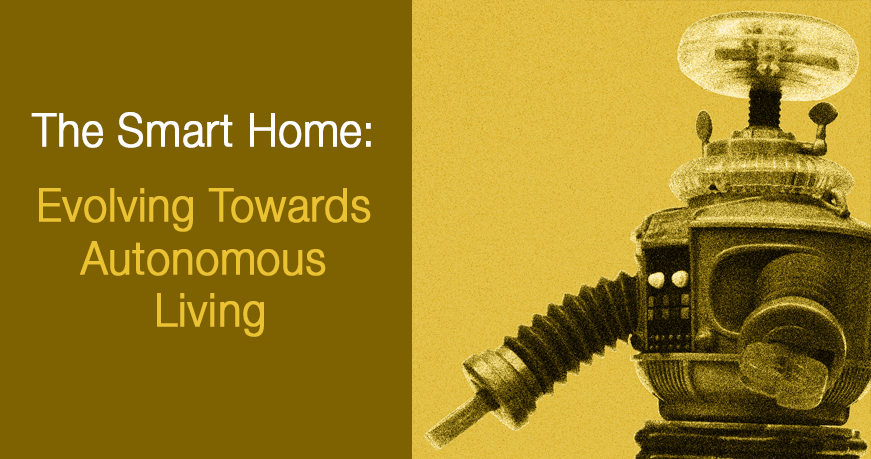These days, there is a lot of concern and angst about artificial intelligence, automation, and robots becoming too much of an influence in our lives. Specifically, many are concerned about robots taking our jobs.
Robots have long been used in manufacturing, performing welding, assembly and many other production tasks. Now they’re making their way into the front office, replacing people for tasks like procurement and accounting.
Even some journalism is being performed by robots. We can only hope they don’t figure out how to do advertising.
In contrast to the angst, proponents of automation say that the jobs machines and computers do are mundane and repetitive, giving us as mere humans more time to do more humany things. We’re not here to take a position on that, but there is a relevant point for home products brands (you knew we’d get there eventually).
 Just like the modern factory and warehouse are becoming autonomous, so too is the modern home. A recent Design Boom article predicted that homes will become autonomous in the coming years. The average home, the article states, could contain upwards of 500 smart devices within the next five years.
Just like the modern factory and warehouse are becoming autonomous, so too is the modern home. A recent Design Boom article predicted that homes will become autonomous in the coming years. The average home, the article states, could contain upwards of 500 smart devices within the next five years.
If 500 seems like a lot, it is. But the way things are going, it might not be too hard to imagine. These smart devices will, and in many cases already are, start doing the mundane, repetitive things for us. That will free up our time to do more important, humany things, like taking naps.
Over the last few years, we’ve become accustomed to entertainment products — sound systems, TVs — being internet- and smartphone-connected. Then, we were introduced to products like Nest’s smart thermostats and technology-enabled door locks from Kwikset, not to mention internet-connected security systems. Then we became familiar with the likes of Alexa and other hubs that let us control certain functions in our home with voice commands.
Marc Andreessen famously said “software is eating the world” in 2011. What he meant was that every company will essentially become a software company, or they should if they want to survive, because consumers will expect everything to be intuitive, connected, smart, digital.
So far, smart products for the home have made sense, for the most part. But now manufacturers, from startups to established brands, are taking Andreessen’s words to heart and are trying to jam technology into their products in an effort to find the Next Big Thing.
The results have been, shall we say, mixed.
On the one hand, we have truly innovative devices, like Samsung’s Family Hub refrigerator, which offers a touch screen to let consumers manage groceries, keep calendars up to date, and even post photos. It’s basically a digital magnet for sticking stuff to the refrigerator. A magnet that can order your groceries.
 We also really like the Genican device that keeps track of what you throw away by scanning barcodes on empty packages as they go into your trash bin. That helps you keep an inventory of your groceries, so you know when you’re running low on the important ones, like coffee or beer.
We also really like the Genican device that keeps track of what you throw away by scanning barcodes on empty packages as they go into your trash bin. That helps you keep an inventory of your groceries, so you know when you’re running low on the important ones, like coffee or beer.
However, some companies are pushing technology to the point of ridiculousness. There is a smart duvet that makes your bed for you when you’re away. There is a smart umbrella that keeps you informed of the weather so you can remember to bring it with you. Finally, there is a device that keeps track of the number of eggs you have and how soon they will be spoiling.
We’re all for technology, but honestly, do we really need notifications on our phones that we should think twice about that omelette because our eggs aren’t fresh enough? It seems like we’re quickly approaching the maximum number of notifications people will tolerate.
And that brings us around (finally) to the marketing point of all this. As marketers, we have to be sensitive to what consumers want and don’t want. We need to recognize that the customer experience is going to be the competitive advantage, and it’s a powerful tool to use in our marketing efforts.
As companies chase the next big digital thing, there will be some breakthroughs, but many more flops. As marketers, we need to be as close to the customer as possible. Put ourselves in their shoes, so we can have an idea if a new product will truly enhance their lives in a compelling way, or if it’s superfluous and silly.
We can’t know what the next big thing will be, but we can try our best to be the voice of the consumer, so we can help shape the products and messages that will resonate with them.
Want to talk more about technology? Meet me at PCBC in June and let’s talk about how technology is affecting your brand landscape in this fast-changing market.




